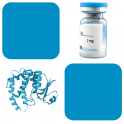
- Remove this product from my favorite's list.
- Add this product to my list of favorites.
Products
Viewed products
Newsletter
 |  |  |  |  |  |

Background
Beta-secretase 1 (BACE1) also known as beta-site APP cleaving enzyme 1 (beta-site amyloid precursor protein cleaving enzyme 1), memapsin-2 (membrane-associated aspartic protease 2), and aspartyl protease 2 (ASP2), β-Secretase , and is a member of the peptidase A1 protein family, BACE1 is a type I integral membrane glycoprotein and aspartic protease that is found mainly in the Golgi. BACE1 is an aspartic-acid protease important in the pathogenesis of Alzheimer\'s disease, and in the formation of myelin sheaths in peripheral nerve cells. The transmembrane protein contains two active site aspartate residues in its extracellular protein domain and may function as a dimer. This protease is responsible for the proteolytic processing of the amyloid precursor protein (APP). Generation of the 40 or 42 amino acid-long amyloid-β peptides that aggregate in the brain of Alzheimer\'s patients requires two sequential cleavages of the APP. Extracellular cleavage of APP by BACE creates a soluble extracellular fragment and a cell membrane-bound fragment referred to as C99. The elevation of BACE1 levels can be induced by amyloid plaques surrounding neurons at early stages of pathology before neuron death occurs, and may drive a positive-feedback loop in AD.
Source
Recombinant human BACE1 (rhBACE1) protein, His Tag (BA1-H5220) is expressed from human 293 cells (HEK293). It contains AA Thr 22 - Thr 457 (Accession # NP_036236.1).
Predicted N-terminus: Thr 22
Molecular Characterization
This protein carries a polyhistidine tag at the C-terminus.
The protein has a calculated MW of 49.3 kDa. The protein migrates as 55-66 kDa under reducing (R) condition (SDS-PAGE) due to glycosylation.
Endotoxin
Less than 1.0 EU per μg by the LAL method.
Purity
>95% as determined by SDS-PAGE.
>95% as determined by SEC-MALS.
Formulation
Lyophilized from 0.22 μm filtered solution in PBS, pH7.4 with trehalose as protectant.
Reconstitution
See Certificate of Analysis for details of reconstitution instruction and specific concentration.
Storage
For long term storage, the product should be stored at lyophilized state at -20°C or lower.
Please avoid repeated freeze-thaw cycles.
This product is stable after storage at:
-20°C to -70°C for 12 months in lyophilized state;
-70°C for 3 months under sterile conditions after reconstitution.
Bioactivity
Please refer to product data sheet.
(1) "Modulating Mitochondrial Dynamics Mitigates Cognitive Impairment in Rats with Myocardial Infarction"
Jinawong, Piamsiri, Apaijai et al
Curr Neuropharmacol (2024)
(2) "Acetylcholinesterase: A Versatile Template to Coin Potent Modulators of Multiple Therapeutic Targets"
Luque, Muñoz-Torrero
Acc Chem Res (2024) 57 (4), 450-67
(3) "Design, Synthesis, and Biological Investigation of Quinazoline Derivatives as Multitargeting Therapeutics in Alzheimer's Disease Therapy"
Verma, Waiker, Singh et al
ACS Chem Neurosci (2024) 15 (4), 745-771
Showing 1-3 of 723 papers.
Follow us